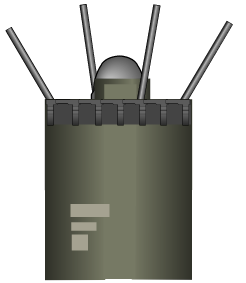Sammakko 67
| Sammakko 67 | |
|---|---|
 | |
| Type | Anti-personnel bounding mine |
| Place of origin | Astronea |
| Service history | |
| In service | 1967-present |
| Used by | Astronean Armed Forces |
| Production history | |
| Designer | Ostresh Advanced Systems |
| Designed | 1960s |
| Manufacturer | ACC Defence Division |
| Unit cost | $110 |
| Produced | 1967-present |
| Specifications | |
| Length | 205 mm (8.1 in) |
| Diameter | 130 mm (5.1 in) |
| Effective firing range | 123 m (135 yd) |
| Filling | Composition B |
| Filling weight | 0.42 kg |
Detonation mechanism | 10 kg push or 6 kg pull |
| Blast yield | 25 m (fatal), up to 200 m (injury) |
| References | |
The Sammakko 67 is a bounding anti-personnel mine designed for area denial, concealed most frequently by being buried into earth or sand. It was designed by Ostresh Advanced Systems in the 1960s, and entered full scale production in 1967 after successful marketing to the Astronean Armed Forces.
It has been exported to numerous former Astronean colonies, and is one of the most widespread models of mine still found in Altsea today.
Sammakko mines are typically buried deeply, with only the plastic head protruding, making it difficult to detect among heavy undergrowth.
Design
The Sammakko 67 has a short, tubular plastic body which houses the steel bounding of the mine. On top of the mine is a round fuze cap with five prongs. It features an anti tampering device that self destructs the mine if disarming attempts are made.
The mine is triggered when the fuze cap tilts, either because of pressure on one of the five prongs or a pull on an attached tripwire. The tilting fuze mechanism is not affected by overpressure. When the mine is triggered, a spring-loaded firing pin fires a percussion cap inside the fuze, which ignites a propelling charge at the base of the mine. The propellant charge launches the mine up out of the ground and into the air. When the mine reaches a height of approximately 50 cm above ground, an integral tether wire (connecting it to the plastic body from which it was launched) tugs on a spring-loaded firing pin in the body of the mine, which detonates the main explosive charge.
Embedded in a plastic fragmentation sleeve surrounding the main explosive charge are approximately 1,000 pre-cut steel fragments, which are projected at high velocity in all directions. The mine has a lethal radius of 25 m, but the fragments remain dangerous at a considerable distance beyond that e.g. can inflict deeply penetrating eye wounds. The time taken from triggering the mine to detonation is approximately one second, so there is no time to take cover from the blast.
Ostrech also designed an anti-handling device for its mines, designated the ATT-7C. This is a tilt-operated device, specifically designed to be fitted to any of Ostrech's products. The ATT-7C has a series of fuze adapters which allow it to be screwed into the bottom of any of those mines. It has a 10-minute mechanical arming delay (started by removing a pin) followed by a 30-minute electronic arming delay. Two 1.5 V batteries supply power to the device, its operational life is longer than a year.